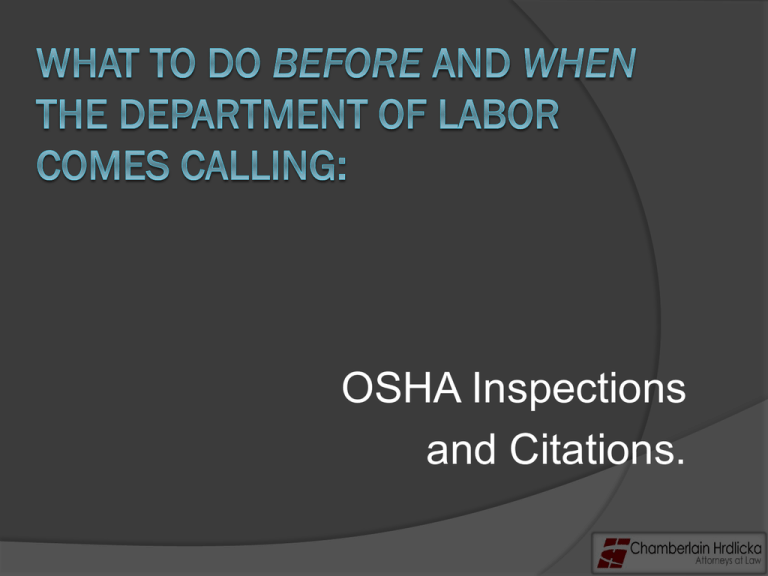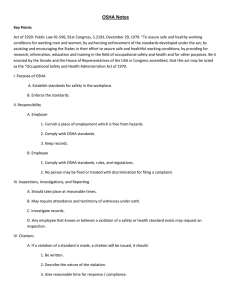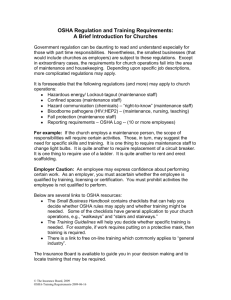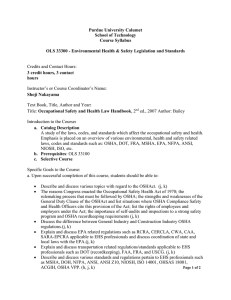What to Do - Texas Lawyer
advertisement

OSHA Inspections and Citations. Inception: Occupational Safety and Health Act (1971). 29 U.S.C. §§ 651-678. Mission: To assure safe and healthful working conditions by setting and enforcing standards and by providing training, outreach, education and assistance. Dallas, TNT, Season 2, Episode 10, Guilt & Innocence Generally applies to all domestic employers and employees. Exempted: Self-Employed. Family farm workers with no outside employees. Regulated by other Agency. ○ MSHA, FAA, USCG, BSEE, etc. OSH Act Sec. 5: General Duty Clause: Each employer shall furnish a place of employment free from recognized hazards likely to cause death or serious physical harm. Specific Standards: 29 CFR 1904 – Recordkeeping 29 CFR 1910 – General Safety 29 CFR 1926 – Construction 29 CFR 1928 – Agriculture OSHA Regulations and the Oil & Gas Industry Oil & Gas Well Drilling, Servicing and Storage Industry Focus. Available at: http://www.osha.gov/SLTC/oil gaswelldrilling/ Frequently Cited: Electrical Wiring and Sys. Guarding Floor/Wall Openings General Duty Clause PPE Hazard Communication OSHA Oil & Gas Directives: Oil Well Derrick Stability: Guywire Anchor Systems. National Emphasis Program: Crystalline Silica. Hazard Information Bulletins: Diesel Exhaust/Diesel Particulate Matter. Barrier Guards for Drawworks Drum at Oil Drilling Sites. Online, interactive website for Oil & Gas Industry. Provides reference to: Applicable standards. Potential hazards (JSA topics). Safe practices. Suggested training. Available at: http://www.osha.gov/SLTC/etools/oilandgas/index.html Presenters from OSHA, NIOSH and Industry Groups focusing on Oil & Gas Industry. Next: December 2-3, 2014. 2012 Conference Presentations Available: http://www.oshasafetyconference.org/Events/ugm/Os ha2012/ Implementing Safety Standards OSHA Compliance Safety and Health Officer. Unscheduled and Scheduled Inspections. May include examination of: Required record keeping. Workplace and site safety evaluation. Abatement and compliance assessment. CSHO Inspection Priorities : 1. Imminent Danger Assessment. 2. Catastrophe/Fatality Investigation. 3. Worker Complaints. 4. Targeted Inspections (National Emphasis Programs). 5. Follow-up of Prior Inspections for Abatement and Compliance. CSHO Must: Present credentials and define scope. Reasonable accommodations for business. Allow employer/employee representatives to observe. CSHO May: Visually observe workplace, photograph and sample. Review required records, placards and postings. Interview employees and take statements. Request additional documentation. Closing Conference Note violation(s) observed and nature. Identify possible abatement measures/deadlines. Detail employee rights and non-retaliation rules. Employer’s opportunity to correct factual errors. Do not admit violation(s)! Citation, Penalties and Procedure Citation and Notification of Penalty: Violated standard(s) observed during inspection. Assessment of penalty(ies). Abatement requirements and deadlines. Posting and notification requirements. “Serious”: Substantial probability of death or serious harm. Up to $7,000 per violation. “Other than Serious”: Probably not cause death or serious harm. Up to $7,000 per violation. “De Minimis”: Employer implemented different measure with no immediate safety concern. “Repeated”: If cited within 5 years for same/substantially similar condition. Up to $70,000 per violation. “Willful”: Intentional disregard or plain indifference to employee safety. Up to $70,000 per violation. Possible criminal charges. Explanation of violations cited. Explanation of applicable standards. Specific standard or General Duty Clause. Discuss abatement measures and timing. Negotiate informal settlement agreement. Resolve disputed Citations and penalties. Penalty negotiation. Agree and accept violations and penalties; or contest Citation, proposed penalty(ies) and abatement date. Compliance for Uncontested Citation: Pay penalty(ies). Abatement compliance certification. Petition for Modification of Abatement: Seek delay in abatement period or abatement actions. Notice of Contest: Must be served within 15 working days from receipt of Citation. Commencement of Contest: Sec. of Labor files Complaint within 20 days. Employer files Answer within 20 days. May elect “Simplified Proceedings.” Discovery governed by OSHRC Rules. Evidentiary hearing before ALJ governed by Federal Rules of Evidence. Petition for Discretionary Review of ALJ decision before Review Commission. If not directed for review, employer may file petition for review in Court of Appeals. Secretary of Labor has initial burden: 1. Applicability of cited standard; 2. Employer’s non-compliance with standard; 3. Employee access to violative condition; and 4. Employer’s actual or constructive knowledge of violation. Isolated Employee Misconduct: Adequate plan for training and supervision with specific instruction, but no employer knowledge of misconduct. Impossibility/Greater Hazard: Compliance with requirements would have been functionally impossible or precluded task and no alternative means available. Infeasibility of Abatement: Means of compliance would have been infeasible or necessary work would be infeasible after compliance, and alternative means used or no feasible alternative. Multi-Employer Citation Policy: Employer did not cause hazard or control conditions, but took reasonable steps to notify causing party and to protect employees. How to Avoid Headaches in Dealing with OSHA Take advantage of available OSHA training. Engage outside counsel before issues arise. Know what to expect during inspections. Take Advantage of Informal Conference and Contest Citations. Be proactive at every step! OSHA funding for inspections has not decreased. OSHA has many training and compliance resources available at little to no cost. HS&E personnel must identify and comply with standards and recordkeeping. Illness and Injury Prevent Policy (I2P2). OSHA 300, 300-A and 301. Paper the file! Majority are unscheduled inspections. In the heat of the moment is not the time to make important decisions. Prepare beforehand! Engage outside counsel before inspection occurs. ○ Work product privilege if subsequent litigation. Identify Inspection Response Team. ○ Designate “point person” to accompany CSHO. Should request time for counsel or safety representative to accompany CSHO. CSHO will typically wait if not unreasonable delay. Can deny entry and demand search warrant. Do not have to consent to inspection. OSHA can obtain ex parte. Counsel/safety representative should shadow CSHO. Take identical photos, videos and samples. Request duplicates of all photos, videos, samples and copies of test results. Limit CSHO’s access only to defined scope. Protection of Trade Secrets. Employee interviews: CSHO can interview employees privately. Employee can request employer presence. Employer does have right to speak with employees. No requirement for employee to sign statement. Dallas, TNT, Season 2, Episode 10, Guilt & Innocence Only chance to discuss Citation/violation(s) informally. Discuss applicability of standards cited. If specific standard applicable, it should be cited rather than General Duty Clause. Consider guidance from ANSI, API, IADC, etc. Request abatement assistance and options. Impossibility or Greater Hazard Defenses? Negotiate settlement and penalty. General Duty Clause can only be categorized as “Serious” violation. Specific standards can be “Other than Serious” or lesser violation. Must serve Notice of Contest within 15 working days of receipt of Citation. Informal Conference does not stay deadline. Must plead affirmative defenses. Must prepare for evidentiary hearing like any trial and make complete record.





